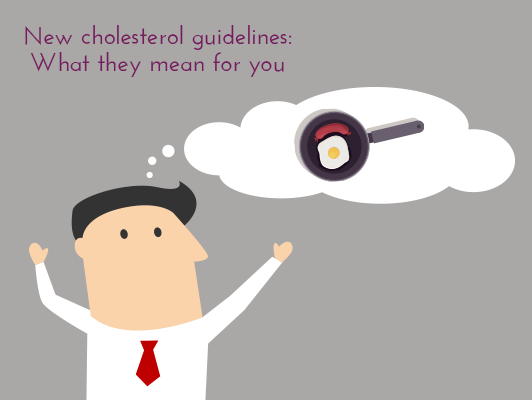New cholesterol guidelines: What they mean for you
You may have heard about the new proposed cholesterol guidelines from the 2015 Dietary Guidelines Advisory Committee to relax the rules on dietary cholesterol intake after decades of it being on the “caution” list. All these changes can be confusing! Let’s take a look at the new cholesterol guidelines, how they were proposed, and what that means in real life.
Some background
The Department of Health and Human Services (HHS), in collaboration with the United States Department of Agriculture (USDA), releases the Dietary Guidelines for Healthy Americans every five years. The latest version of the report is set to be released later this year. The Dietary Guidelines Advisory Committee makes its recommendations for changes to the guidelines early in the year, and it undergoes a period of public comment. During this time, anyone can review the report (see the full report here), and make comments and recommendations on it. Once the public comment period is over, the government will review the committee’s recommendations and public comments. Then they will determine how to use the information in the new release of the Dietary Guidelines.
The controversy
Health advocacy groups and organizations had previously recommended a daily intake of no more than 300 mg of dietary cholesterol to decrease the risk of heart disease. More recent research, however, has suggested that the cholesterol in foods you eat has less to do with your blood cholesterol levels than previously thought. It turns out that many high-cholesterol foods are also high in saturated fat. Once these compounds could be isolated and studied by themselves, researchers realized the saturated fat was the bigger factor in blood cholesterol levels. Many health professionals have been discussing the new research findings with clients for years, so you may have heard something similar from your doctor already.
What does this mean to me?
For people already eating a healthy diet, little will change in light of these new cholesterol guidelines. The guidelines for cholesterol may be relaxed, but the guidelines for saturated fat remain unchanged at 10 percent or less of daily calorie intake. You should still limit your intake of these foods that are high in cholesterol and saturated fat:
- Red meat, like beef and pork
- Bacon and sausage
- Butter and lard
- Whole and 2% milk, cream
- Ice cream
- Full fat yogurt
- Cheese
A few foods, though, are high in cholesterol, but not saturated fat. These are foods whose intake restrictions can be relaxed for most people:
- Eggs
- Shellfish
- Liver
A final note
It is important to always consult your physician for individualized treatment approaches. While most people can probably safely consume dietary cholesterol, others are more sensitive to it. Those people may see a rise in blood cholesterol levels as a result of eating dietary cholesterol. Your doctor can help you decide if you should be concerned about dietary cholesterol.
Will these new proposed guidelines affect how you eat? Let us know what you will change (or not) in the comments!




